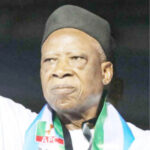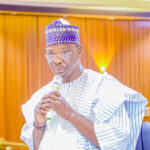As a painter and art curator, Jonathan Adamu has experience in the art world spanning over 20 years. In this Daily Trust on Sunday interview, he takes us through the lens of a curator and process of curating art.
How do you balance your role as an artist with your responsibilities as an art curator?
Honestly, balancing both is not easy. Being the curator of a gallery full-time takes up a lot of my time, so I have to be creative with how I’m able to produce works of art. There is a saying that passion drives purpose, as long as I’m passionate about my art, there is always room to create. It is a step-by-step process and it takes a lot of planning, scheduling time to effectively produce artworks. Though there are both positives and negatives, the positive being there is no shortage of inspiration, there is always a new idea and something ground breaking to try out. While the negatives are being burnout and not being able to create at any given time. There is no room for spontaneity so, occasionally you feel trapped seeing art and not being able to create. At the end of the day, a compromise has to be made and it is a challenge I always look forward to.
What inspired you to take on the role of an art curator in addition to being an artist?
Telling an engaging story of creativity through the various works of art in a collection, basically trying to interpret and convey an artist message in a way that onlookers will be able to understand and appreciate within the context of a given theme and type of art space or an exhibition space. Also, the learning experience, different interactions will always force you to learn. There is always something new and different to try out and it’s easier to learn from the works of others. It helps to build you up as an artist.
How does your work as a curator influence your artistic practice and vice versa?
Due to the constant exposure to art and art history of works in a collection, I’m constantly learning, tailoring my skills to specific art genres, seeing ways to improve and evolve. Being a curator gives me access to artists and I am able to rub minds with a lot of creative minds and get advice and they show me different areas to improve.
As an artist, you must always be open to criticism. Being an artist also gives me a glimpse into the mind and style of artists I curate, it gives a better understanding of their creative process, it makes it easier to break down their style and gives a better insight into how they do what they do.
Can you describe your approach to curating exhibitions? What factors do you consider when selecting artworks?
Speaking with the artist and also doing some research on the artist and their style to understand the message they’re trying to pass across with their art. It also depends on the space that a work is going to be exhibited in, there can’t be one without the other. For exhibitions, there is always a theme, so the goal is making everything connect with each other. A theme gives an exhibition direction so it helps to guide the artist on the type of works to create and also choose for exhibitions.
How do you stay connected to the art community as both an artist and a curator?
Constantly visiting other galleries as well as attending art exhibitions, following different artists on social media helps to keep up with various trends. There are also different fora and platforms available. As an artist and curator, it is always important to network.
In what ways does curating exhibitions enhance your understanding and appreciation of different artistic styles and mediums?
It gives a better understanding and appreciation of artists’ creative process and mode of expression. Every artist is different and every style is produced differently by different artists. Works of art are always personal to artists so even if two artists do the same thing, there is always a different depth and meaning to them. There are no restrictions with creating asides from the mind of an artist, freedom of expression allows an artist not to be restricted because anything and everything is possible with art.
How do you engage with the audience through your curated exhibitions?
I engage them by taking them on a journey, I believe there should always be a starting point and a destination, they shouldn’t leave the exhibition how they came into it. I try to create a memorable experience with the pieces I exhibit; there should be a flow and sometimes a method to the madness, everything they see should relate to each other. As an artist, I also help them to understand art on a more technical level, breaking down how the artist actually do what they do, the type of paint they use, the technique and genres. It all helps to demystify art and make is appear less complicated than it is. I have a saying ‘it’s not that deep’.
What do you hope viewers will take away from the experience?
I’d hope that their experience would be their newfound appreciation, bridging the gap between a work of art and onlookers. My aim is to help people have a connection with artworks because they tend to see but they do not understand and interpret the art works they see. So, if I’m able to make the artworks I curate digestible and understood within the context in which they are displayed or exhibited, then the aim is achieved.
What challenges do you face in your dual role as an artist and curator, and how do you overcome them?
Making time to create while working a full-time job, there has to be separation, if not, one will supersede the other, so I balance both. I overcome this hurdle by planning when I produce art and making myself accountable to my process, I cannot allow myself to be complacent because there is always a goal in sight.
Can you share a memorable experience or achievement from your career as both an artist and a curator?
There have been too many, but if I were to single out two, as an artist I would say my first commissioned painting which I presented to the former SGF, Boss Mustapha, and as a curator being part of the team that put together ‘The master and the prodigy’ exhibition featuring Prof Bruce Onobrakpeya and Kanyeyachukwu at the Orisun Art gallery.
What challenges do you face when curating exhibitions, and how do you overcome them?
I wouldn’t really call them challenges but rather lessons and learning experiences. I’ve found that there are always solutions as long as you’re open to thinking outside of the box, you’d end up being positively surprised with the outcomes.
How do you stay updated with current trends and emerging artists in the art world?
I stay updated through social media, art forums and articles. Art is constantly changing and evolving. Being a curator, new and emerging artists always reach out to me.
Can you share any insights into the process of collaborating with artists when curating an exhibition?
Artists tend to take the first step and reach out with an idea in mind, then taking the time to understand the artist and the story the artist intends to tell, basically getting to know the artist better will give more insight into their collection.
What do you consider to be the role of the curator in shaping the discourse around contemporary art?
I feel curators make art more accessible and digestible to the masses and enthusiast because it is all about communication. Curators aid in documenting and pushing art forward to the wider art world. Curators often act as a guide for both artists and art enthusiasts.
How do you see the future of art curation evolving, and what excites you about it?
The inclusivity of it, art is constantly evolving and artists are always discovering new ways to create and express themselves, so being able to interpret and tell their story, exploring different creative outlets moving with the times and constantly staying updated as to not be left behind, we are in the digital age so everything is at a much faster pace. The digital age has given a platform that the art world can use to try different ways from the norm, there are virtual avenues that can be used now, having a physical space isn’t the only way to exhibit works of art so exhibitions are made more accessible, augmented and virtual reality has provided new challenges and solutions for works to be seen and interacted with. Now, art can be interacted with from almost everywhere in the world. So much more can be done and because of the internet, there aren’t as much restrictions.




